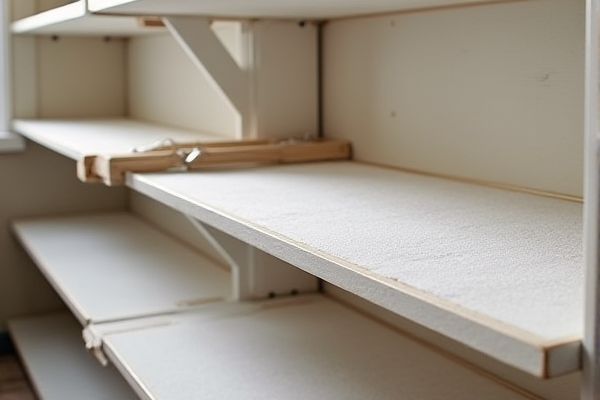
Fabric shelf liners offer breathable protection that helps prevent mold and mildew, while plastic shelf liners provide a waterproof barrier that is easy to wipe clean and resist spills. Discover which type of liner best suits your storage needs by reading the rest of the article.
Table of Comparison
| Feature | Fabric Shelf Liner | Plastic Shelf Liner |
|---|---|---|
| Material | Cloth, cotton, polyester | Vinyl, PVC, polyethylene |
| Durability | Moderate; prone to staining and wear | High; water-resistant and easy to clean |
| Water Resistance | Low; absorbs moisture unless treated | Excellent; waterproof and stain-resistant |
| Cleaning | Machine washable or spot clean | Wipe with damp cloth or mild cleaner |
| Non-slip | May require additional grip backing | Often has textured surface for grip |
| Eco-friendliness | Biodegradable and natural fibers | Non-biodegradable; synthetic plastic |
| Appearance | Soft, flexible, various patterns | Smooth, shiny, limited patterns |
| Price | Moderate | Low to moderate |
Introduction to Fabric and Plastic Shelf Liners
Fabric shelf liners offer a breathable, eco-friendly surface that prevents items from slipping while absorbing moisture to keep shelves dry. Plastic shelf liners provide a waterproof barrier with easy-to-clean, durable protection against spills and stains, ideal for kitchen and bathroom storage. Your choice depends on whether you prioritize natural, textured comfort or waterproof, low-maintenance functionality.
Material Composition: Fabric vs Plastic
Fabric shelf liners are typically made from natural fibers like cotton or polyester blends, offering breathability and a soft surface that helps prevent scratches on your shelves. Plastic shelf liners are composed of vinyl or polyethylene, providing a waterproof, easy-to-clean barrier ideal for protecting against spills and moisture. Choosing between fabric and plastic shelf liners depends on whether you prioritize breathability and aesthetics or durability and moisture resistance.
Durability and Longevity Comparison
Fabric shelf liners offer superior breathability and resistance to tearing, making them ideal for long-term use in cabinets and drawers, while plastic shelf liners excel in water resistance and easy cleaning but may become brittle or crack over time. Durability of fabric liners depends on the quality of materials such as cotton or polyester blends, which can withstand repeated washing and wear, whereas plastic liners often degrade under sustained sunlight exposure or temperature fluctuations. Longevity favors fabric liners in dry, moderate environments due to their resilience and ability to maintain shape, contrasting with plastic liners that perform better in moist or spill-prone areas but typically require replacement more frequently.
Ease of Installation and Maintenance
Fabric shelf liners offer a simple installation process, often requiring just cutting to size and placing on shelves without adhesive, making them easy to adjust or remove. Maintenance involves occasional washing or spot cleaning to keep them fresh and free of dirt. In contrast, plastic shelf liners may require trimming and securing with adhesive or fasteners, and cleaning involves wiping down surfaces to prevent stains and buildup, offering a more water-resistant but less breathable option.
Water and Stain Resistance
Fabric shelf liners offer moderate water resistance but tend to absorb spills, making them susceptible to stains and requiring frequent cleaning. Plastic shelf liners provide superior water and stain resistance due to their impermeable surface, effectively preventing liquid penetration and making them easier to wipe clean. For areas prone to moisture or frequent spills, plastic liners deliver enhanced protection and durability compared to fabric options.
Impact on Shelf Surface Protection
Fabric shelf liners provide excellent surface protection by cushioning shelves and preventing scratches, while allowing airflow to reduce moisture buildup that can damage the shelf material. Plastic shelf liners offer a waterproof barrier that effectively protects against spills and stains but may trap moisture, potentially leading to shelf surface deterioration over time. Your choice depends on whether you prioritize moisture control or spill resistance for optimal shelf longevity.
Aesthetics and Design Options
Fabric shelf liners offer a wide variety of patterns, textures, and colors, enhancing the visual appeal of shelves with a soft, natural look. Plastic shelf liners typically provide a glossy, smooth finish and come in limited design options, mainly focusing on functionality and ease of cleaning. The choice between fabric and plastic liners depends on whether aesthetic versatility or practical durability is prioritized in the space.
Environmental Impact and Sustainability
Fabric shelf liners, often made from natural fibers like cotton or bamboo, offer a biodegradable and renewable alternative to plastic shelf liners, significantly reducing environmental pollution and landfill waste. Plastic shelf liners, typically derived from petroleum-based materials, contribute to microplastic pollution and have a prolonged decomposition timeline, exacerbating ecological harm. Choosing fabric liners supports sustainability through compostability and reduced reliance on fossil fuels, aligning with environmentally responsible consumption.
Cost Analysis: Fabric vs Plastic Shelf Liners
Fabric shelf liners generally have a higher initial cost compared to plastic shelf liners but offer better durability and reusable benefits, making them cost-effective over time. Plastic shelf liners are typically cheaper upfront but may wear out faster, requiring frequent replacements that increase long-term expenses. Your choice depends on balancing upfront investment with longevity and maintenance needs for optimal cost efficiency.
Best Use Cases for Each Liner Type
Fabric shelf liners excel in breathability and cushioning, making them ideal for delicate items like glassware, china, or pantry shelves with dry goods. Plastic shelf liners provide waterproof, stain-resistant protection, perfect for kitchen cabinets, refrigerators, or areas prone to spills and moisture. Choosing between the two depends on whether moisture resistance or soft protection is the primary requirement for the storage environment.
 homyna.com
homyna.com